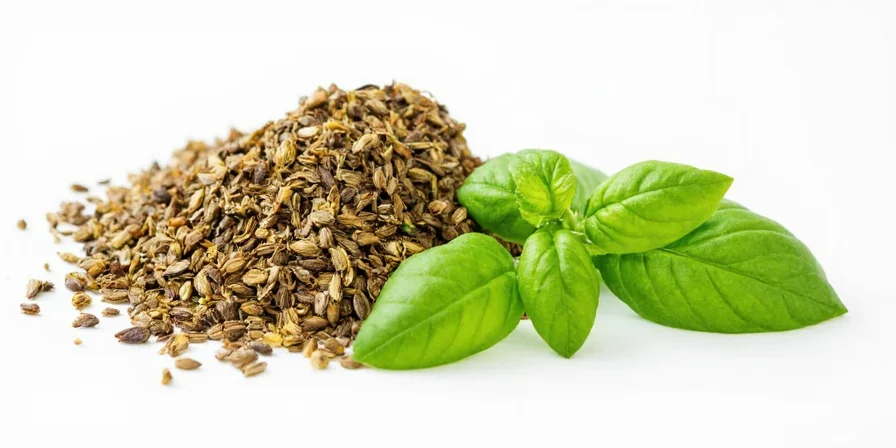Basil Swap Secrets: How Much Dried Basil Equals 1/2 Cup Fresh?
Table of Contents
- Introduction: Why Your Spice Cabinet Should Never Be Boring
- The Magic Ratio: How Much Dried Basil Equals 1/2 Cup Fresh?
- Why the Conversion Matters
- Spice Storage Tips That’ll Keep Your Herbs Fresh Longer
- Pro Usage Hacks for Dried Basil and Beyond
- Other Herb & Spice Swaps You Need to Know
- Bonus Tip: Make Your Own Dried Basil at Home
- Summary: The Basil Conversion Cheat Sheet
Introduction: Why Your Spice Cabinet Should Never Be Boring
If you’ve ever stared into your spice drawer like it’s a void of forgotten flavors, you’re not alone. But today is your lucky day — because we're diving deep into one of the most common kitchen conundrums: How much dried basil equals 1/2 cup fresh?
The Magic Ratio: How Much Dried Basil Equals 1/2 Cup Fresh?
Alright, let’s get right to it — the question that brought you here:
| Fresh Basil | Dried Basil |
|---|---|
| 1/2 cup chopped fresh basil | ≈ 2 tablespoons dried basil |
So if your recipe calls for ½ cup fresh basil, reach for just 2 tablespoons of dried basil. It might seem like a tiny amount, but trust us — herbs pack a punch when they’re dried.
Why the Conversion Matters
You might be wondering why such a drastic difference exists between fresh and dried herbs. Here's the lowdown:
- Fresh herbs are full of moisture and have a more delicate flavor profile.
- Dried herbs are concentrated — both in aroma and taste — since the water content has been removed.
In short, dried basil brings the flavor intensity like a turbocharged version of its leafy cousin.
Spice Storage Tips That’ll Keep Your Herbs Fresh Longer
Now that you know how to swap fresh basil for dried, let’s make sure your dried basil stays as fragrant and flavorful as possible. Here are some expert-level storage hacks:
- Keep it cool and dark: Store spices away from heat sources and direct sunlight. A pantry or cabinet is ideal.
- Air-tight containers only: Oxygen is the enemy of flavor. Use sealed jars or resealable spice bottles.
- No finger-dipping allowed: Moisture from your fingers can degrade the quality of your herbs. Use a spoon instead.
- Label everything: Especially if you're drying your own herbs — date them so you know when to refresh.

Pro Usage Hacks for Dried Basil and Beyond
Just because something’s dried doesn’t mean it should be used like chalk dust on pizza. Here are some clever ways to maximize the potential of dried basil:
- Bloom it in oil: Heat a splash of olive oil in a pan and add dried basil before adding other ingredients. This wakes up the oils and boosts flavor.
- Infuse dressings: Add a pinch to vinaigrettes or mayonnaise-based sauces for a herbal twist.
- Mix with salt: Blend with sea salt to create an all-purpose seasoning for grilled veggies or pasta.
- Add early in cooking: Unlike fresh basil, which is often added at the end, dried basil benefits from being cooked longer to release its flavor.
Other Herb & Spice Swaps You Need to Know
Once you master the basil conversion, why stop there? Here are a few more common herb swaps every cook should have tucked away:
| Fresh Herb | Dried Equivalent |
|---|---|
| Cilantro (coriander) | Not interchangeable — use seeds (coriander) for different flavor |
| Rosemary | 1 tbsp dried = 1 sprig or 3 tbsp fresh |
| Oregano | 1 tsp dried = 3 tsp fresh |
| Thyme | 1 tsp dried = 1 tbsp fresh |
| Parsley | 1 tbsp dried = ¼ cup fresh |
Bonus Tip: Make Your Own Dried Basil at Home
If you find yourself with an abundance of fresh basil, why not dry it yourself? Here’s a super simple method:
- Wash and thoroughly dry basil leaves.
- Remove leaves from stems.
- Spread out in a single layer on a baking sheet lined with parchment paper.
- Place in oven at 170°F (75°C) for about 2–3 hours until completely dry and crisp.
- Let cool, then crush and store in an air-tight container.
Pro tip: You can also air-dry basil by hanging small bunches upside down in a warm, dry place.
Summary: The Basil Conversion Cheat Sheet
Let’s recap this article’s key takeaways in case you need a quick refresher:
- 1/2 cup fresh basil = 2 tablespoons dried basil
- Dried herbs are more potent due to reduced moisture.
- Store dried basil in a cool, dark, air-tight space for maximum shelf life.
- Bloom dried basil in oil for better flavor infusion.











 浙公网安备
33010002000092号
浙公网安备
33010002000092号 浙B2-20120091-4
浙B2-20120091-4